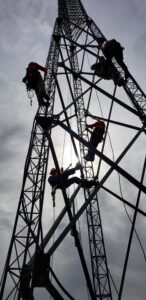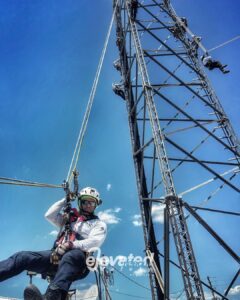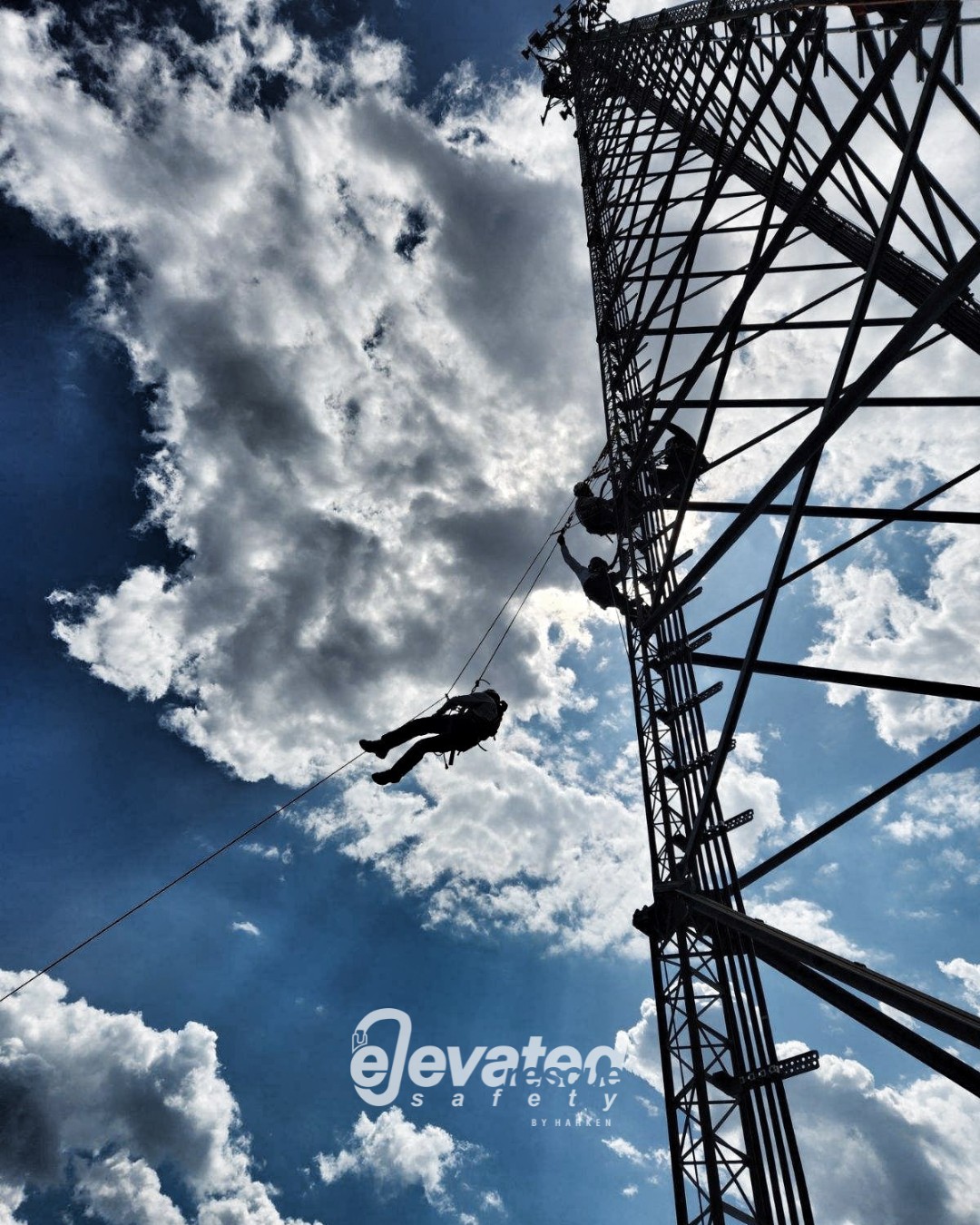Picture your team’s or your academy’s common rope rescue scenario. If yours is anything like that of our local fire/rescue teams, it is in the form of a top-down rescue scenario such as those required for window washers, car-over-the-edge embankment, or for a cliffed-out and stranded hiker. These scenarios allow teams to gather their gear on the rooftop, ledge, or flat deck of the training “cans” and lay out a tarp, get haul teams assembled, rig anchors and a system, then have the rescuer head down to the rescue subject.
Looking From A Different Angle
The top-down rescue training approach is likely the most common scenario practiced around the globe. Even our rescuers and instructors at Elevated Safety were primarily trained using this scenario. Our team has discovered that many professional rescuers stop in their tracks when asked how their team would accomplish a rescue on a tower structure. Tower rescues upturn common rope rescue mindsets by requiring rescuers to assemble and rig on the ground, then climb to the rescue subject with all the necessary equipment to get the subject to the ground.
A Specialty Of Its Own
For many years, the rescue world appeared to look past tower structures and tower climbers in their rescue profiles. Perhaps due to these structures hiding in plain sight in our daily lives with little to no interaction from the Authority Having Jurisdiction (AHJ), took them off our radar. If any agency takes look around their response area many of these structures will be found. According to WirelessEstimator.com (2024), around 134,000 registered communications towers exist in the United States. This emerging situation was recognized by the rescue world when the National Fire Protection Agency (NFPA) added Tower Rescue Awareness, Operations, and Technician levels to both the 1006 and 1670 technical rescue standards starting in 2014. Interested in checking your area? Then look to the AntennaSearch.com website.
An Aerial Haz-Mat Environment

Due to the presence of Radio Frequency (RF) radiation on most cellular and broadcast towers, additional training on RF hazard awareness and the use of RF monitors is strongly recommended. The importance of Lock Out/ Tag Out procedures is quite similar to those required for confined space entry. The National Association of Tower Erectors (NATE) is a great resource for RF hazard awareness training, and their Competent Climber/Rescuer Training Standard is also a great resource when looking to develop a pre-plan for tower rescue. Elevated Safety is a proud member of NATE, and much of our expertise in tower rescue stems from our involvement with NATE over the years.
A Different Approach To Rope Rescue
Why may this rescue be different than what you have trained for? Because a bottom-up approach requires some outside-the-box critical thinking and extensive pre-planning due to the technically diverse components that are unique to the tower rescue discipline. First, rescuers must prepare physically to make the climb up tower with ropes, hardware, gear and sometimes, enough food and water for a long operational period on tall towers. The ascent up tower may be hundreds or, in remote areas, thousands of feet. Few towers under 1,000’ have lift/elevator systems, and the sheer physicality of the climb can test even the fittest of rescuers. Limited and difficult access often means limited rescuers. Tower structures can be limited to a single rescuer being able to go up towers safely due to structural limitations or physical space. The limitations continue as bringing the entire gear cache is not a reasonable option up tower. Rescuers must plan and execute the appropriate rescue systems without the luxury of unlimited access to hardware and additional resources.
Discovering New Techniques
Conceptually adjusting from top-down to bottom-up methodology seems straightforward. Just reverse our process and systems, right? Not necessarily. The differing technical aspects become apparent quickly during the execution of these missions. Task oriented equipment, unfamiliar tools needed for safety climb systems, obstructed climb paths that require navigational skills, and the knowledge of the objective hazards associated with RF Radiation are all requisites for tower rescue. Rescuers who are on a tower need to be skilled in structure climbing with 100% fall protection paired with proper work positioning systems. Aid climbing is another specialized skill used to access subjects in areas of a structure. Vertical mobility on a two rope system can also increase efficiency and safety. Rescuers who are certified Rope Access Technicians though organizations such as the Society of Rope Access Technicians (SPRAT) may have this skill, but proficiency must be maintained through training. Once rescuers access the subject, systems such as twin tensioned rope systems, skate blocks, and tower control systems often prove to be the best options for success.
Where To Begin?

Fortunately, NFPA, several other industry specific organizations, and trainers like Elevated Safety have recognized this gap in the rescue portfolio and stepped up to close it. NFPA 1006, Standard for Technical Rescue Professional Qualifications, outlines the minimum JPRs specific to rescuers to perform rescues on tower structures. NFPA outlines awareness, operations, and technician levels of qualifications. The best initial step for all responders is to achieve a level of awareness of the hazards and approach to these unique rescues. Technical rescuers should prioritize obtaining education and training that meets technician level qualifications. Present standards dictate operations level rescues have pre-established rescue plans for the rescue being executed, which is not common practice and a daunting task in most jurisdictions. Technician level qualified rescuers can develop their action plan during the response, navigate obstructed climb paths, and manage unique rigging on the structure.
How To Train
Elevated Safety has spent over 10 years building a strong tower rescue program specifically for first responders. Our team has taught Tower Rescue Operations Hands-on Training (H.O.T.) classes at the Fire Department Instructors Conference (FDIC) since 2017, working with rescuers from around the world. Elevated Safety runs multiple open enrollment Tower Rescue Technician courses in Illinois, Colorado and Florida each year. The Elevated Safety Tower Technician program provides participants with fundamental individual skills, as outlined in NFPA 1006, and integrates team scenarios that reflect the expectations of set forth in NFPA 1670/2500 for operations and training. After initial training, rescuers must prioritize continued review and practice of these perishable skills at least annually to build muscle memory and ensure confidence when executing the rescue mission.
For more information on our tower rescue courses, visit our website. And check out our Tower Rescue video series on YouTube.
Author: Adam Rothenberg, SPRAT L3, NRP, BSN, RN
Adam is the Technical Curriculum Coordinator for Elevated Safety and a career firefighter/paramedic in the northwest suburbs of Chicago, IL. Adam is assigned to a squad company and is an active member of the Mutual Aid Box Alarm System (MABAS) Division 1 technical rescue team. Adam is a certified Level 3 Rope Access Technician through the Society of Professional Rope Access Technicians (SPRAT).
